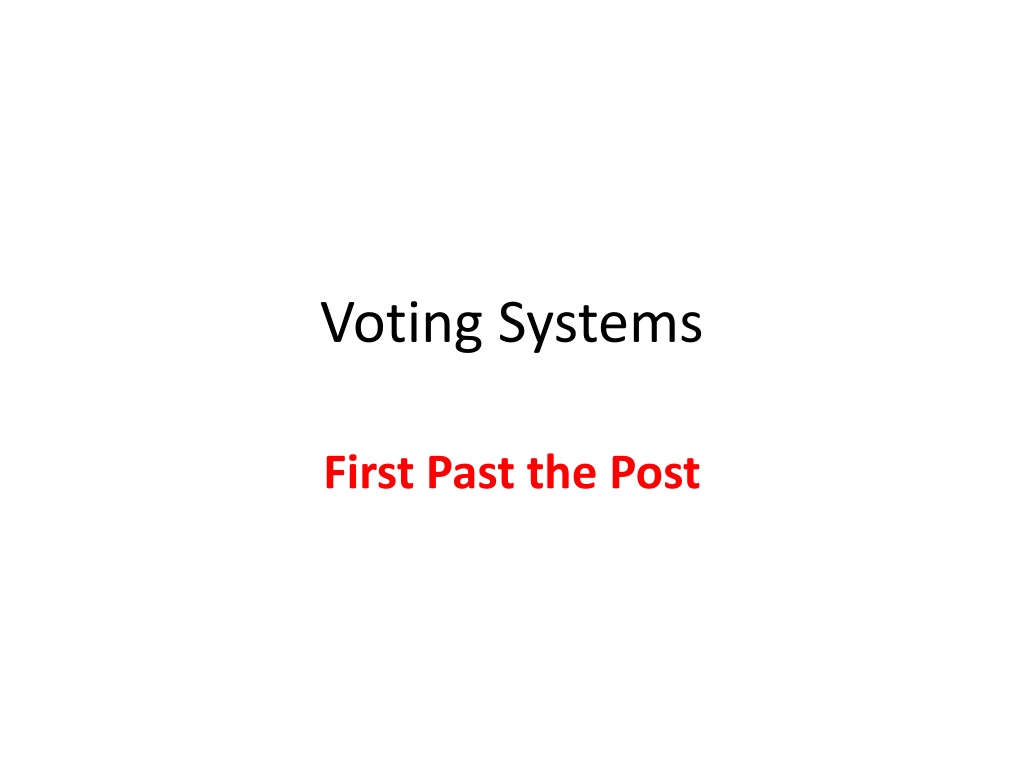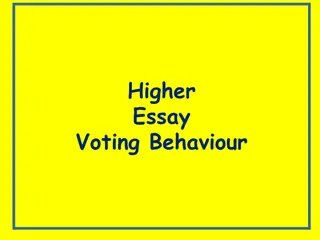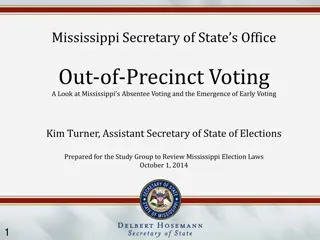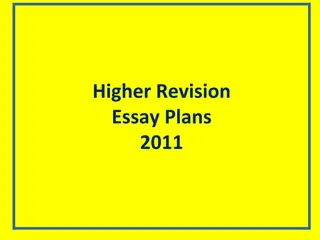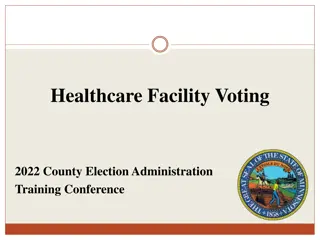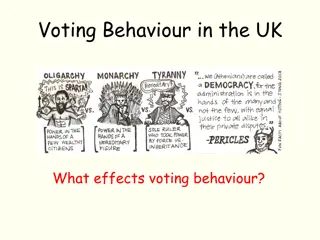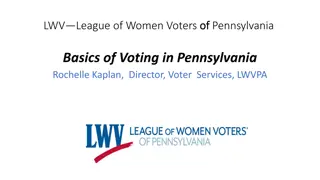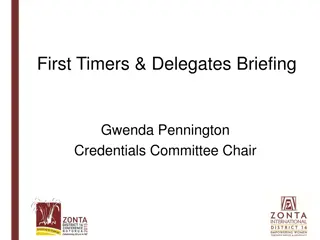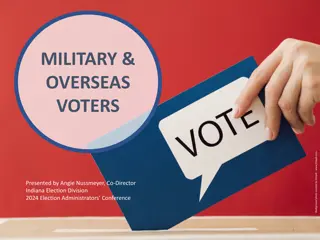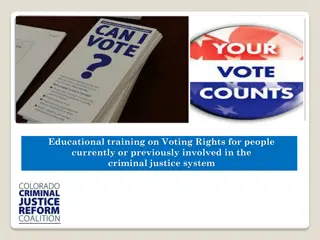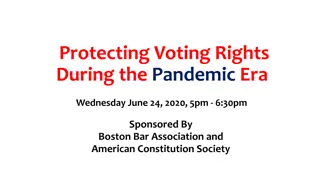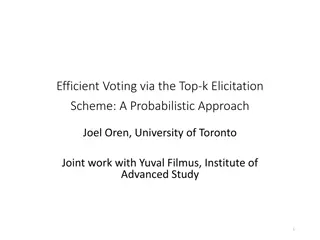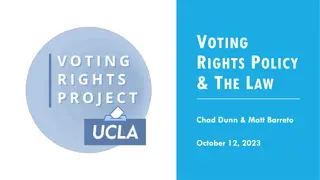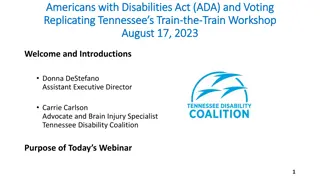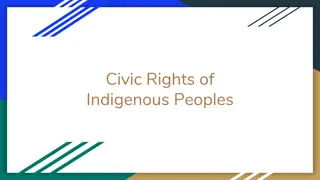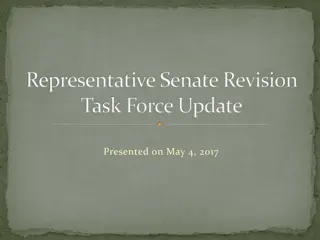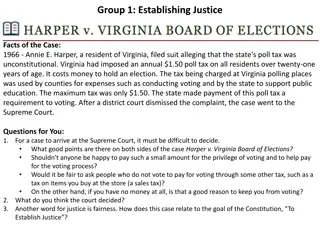Advantages of First Past the Post Voting System
The First Past the Post (FPTP) voting system is simple to understand, as the candidate with the most votes wins. This system has been shown to be fair and democratic, with the winning party generally receiving the most votes overall. Additionally, FPTP is easy to operate, providing quick and understandable election results. It also has the advantage of low incidences of spoiled ballot papers, contributing to fair representation in a democratic society.
Download Presentation

Please find below an Image/Link to download the presentation.
The content on the website is provided AS IS for your information and personal use only. It may not be sold, licensed, or shared on other websites without obtaining consent from the author. Download presentation by click this link. If you encounter any issues during the download, it is possible that the publisher has removed the file from their server.
E N D
Presentation Transcript
Voting Systems First Past the Post
http://www.gladstoneclub.org/images/assets/speakers/20110411151631_1.jpghttp://www.gladstoneclub.org/images/assets/speakers/20110411151631_1.jpg Advantages of First Past the Post
Simple to Understand The person with the most votes wins. Simple! In the Airdrie and Shots constituency, Neil Gray won more votes than any other candidate in the 2017 General Election and was elected as Member of Parliament for that constituency. This clearly suggests that the system is fair as the person who is declared the winner must prove themselves to be more popular than any of the other candidates and so deserves to win. This shows that it is fair and democratic.
Also, overall, more people vote for the winning party than for any other. This makes it fair. For example, the Labour Government gained more votes than any other individual party in 2001 and 2005 and the Conservatives gained most votes in 2010, 2015 and 2017 For example, in 2015 the Conservatives gained 37% of the vote whilst their closest challengers Labour got only 30%. This proves that although in theory there is no connection between the party that wins the most seats and the party that wins most votes overall, the reality is that there is a connection as, in recent years, the party that has won most seats has also always won most votes.
Easy to Operate A simple cross against one candidate followed by a speedy count once the polling stations have closed delivers a quick and readily understandable result. The results of FPTP election are in the newspapers the following day, and usually have been predicted by the early hours of the morning. PR systems are much more complicated, needing the use of preference voting and therefore longer counts.
For example, after the UK General Election, thanks to FTPT, on the 7thMay 2015, people woke up on 8thof May knowing who would be forming the next government. Other evidence which shows that FPTP being easy to operate includes the fact that there re very few spoilt ballot papers. For example, in 2017 less than 1% of ballot papers were spoiled. This percentage is much lower than more proportional systems like the AMS system which is used in the Scottish parliament.
Having a low number of spoilt ballot papers is highly significant in providing fair representation in that one of the central aims of a democratic society should surely be to ensure that the views of the people who have taken the time and effort to attend polling stations have their voices heard.
Accepted FPTP has been used for over a century to elect MP s. The system is well known by the electorate and most governments elected are stable, therefore there is no reason to change the system. Britain is one of the world s most stable democracies. http://rlv.zcache.com/if_it_aint_broke_dont_fix_it_bumper_sticker-rb7b833e0c5b044afbb2074e089fecea5_v9wht_8byvr_512.jpg
2011 Referendum Evidence which supports the fact that the UK public are happy with the current FPTP system is that there was a referendum in 2011 which gave the British public the opportunity to change the FPTP system for UK General Elections to a more representative one if they wanted to the public decided to keep things as they are. This provides further evidence that the general public are not unhappy with the current system.
2011 Referendum Proof that people are happy with FPTP 2011 Referendum Proof that people are happy with FPTP? The extremely low turnout for that referendum (only 42%!) suggesting that people were not overly concerned about changing the current FTPT system.
AND of the disappointing number who did turn out only 32% voted for change - so only 32% of 42% turnout .you get the picture a pretty resounding endorsement of keeping the First Past the Post system!
Strong Decisive Government The governments elected under FPTP are usually strong because they normally have a large majority. This ensures that parties are able to implement their manifesto pledges. Consequently there is clear accountability. However this was not the case between 2010 and 2017 when no single party has an overall majority But generally FPTP ..
Avoids Coalition FPTP generally avoids the creation of coalition governments because parties normally gain an overall majority. Coalition governments can be weak and unstable with small parties holding larger ones to ransom. An example of this is in the Scottish Parliament up until 2011 when the majority party had to share some power with a smaller party (e.g. SNP and Greens)
Once again, since 2017, although the SNP are the biggest party, no single party has an overall majority in the Scottish Parliament meaning that SNP must count on support from other parties (the Greens) in order to pass legislation This is can be viewed positively as it means that there is compromise involved in decision making and it also means that more voter s choices are being represented
MP-Constituency link Only 1 MP is elected and his/her constituents have a directly accountable representative. Example, Marion Fellows in Motherwell and Wishaw if we don t like her performance, then we can vote for someone else.
Under other electoral systems such AMS there are a number of representatives elected, and voters are unsure who to hold accountable.
http://t2.gstatic.com/images?q=tbn:ANd9GcStuCc6a4R5tLdRm5-An063PFqEoRCcv1pwxoK0o0Fr6oofDpCShttp://t2.gstatic.com/images?q=tbn:ANd9GcStuCc6a4R5tLdRm5-An063PFqEoRCcv1pwxoK0o0Fr6oofDpCS Disadvantages of First Past the Post
Favours large parties Parties such as Labour and the Conservatives (and SNP in Scotland) gain at the expense of smaller parties like the Lib/Dems, Greens and UKIP). The two main parties have governed the UK most of the last century. Although the Lib Dems had a role in government between 2010 and 2015, and the DUP from 2017, this is very unusual
http://www.brownbot.com/XNABlog/wp-content/uploads/2010/06/WinnerTakesItAll.jpghttp://www.brownbot.com/XNABlog/wp-content/uploads/2010/06/WinnerTakesItAll.jpg Wasted votes Only 1 more vote than the second candidate is needed to win. People who do not vote for the winning candidate will have wasted their vote as they are not added up across the country. For example, Marion Fellows only got 318 more votes than the Labour candidate in the 2017 general election, and yet the views of the people who voted for the Labour candidate are not being represented in the winner takes all system! http://i.dailymail.co.uk/i/pix/2011/04/23/article-1379804-0ACE164B000005DC-437_233x423.jpg
Lack of proportionality Number of seats in the House of Commons do not accurately reflect the percentage of votes cast for each of the parties. For example the Lib Dems regularly gather a far higher % of votes than they do seats, because they often come second in constituencies.
Also, the winning party tends to be greatly over-represented, for example Labour gaining over 60% of the seats in 2001, with only just over 40% of the vote. A classic example of this lack of proportionality was in 1983, when Labour gained 209 seats with 27.6% of the vote but the Liberal Party won only 23 seats with 25.4% of the vote.
Even in 2017, when both the Conservatives and Labour got a bigger share of the vote than they have done for years neither came close to 50% of the vote (42% and 40% respectively). This clearly indicates that most people have not voted a party other than the party which has won, meaning that the wishes of the majority are being ignored
Recent example of lack of fair representation of FPTP UKIP gained 3.8 million votes (12.6%) of the vote in 2015 but gained only 1 seat!!! How many would they have got under a pure PR system?
Thats right! 12.6% is approximately 1/8th Therefore some would argue that UKIP should get 1/8thof the seats in the House of Commons So (this is your department, Amy!) 650/8 equals 81 MPs!!!
Not democratic Most governments have more people voting against them than for them. No governments since World War II have been elected with over 50% of the vote! http://www.proudtobecanadian.ca/images/PTBCwares/its_true1.jpg
For example, in the 2017 election, both the Conservatives and Labour won more of the total vote than they have done for years but still got nowhere near 50% of the vote Conservatives - 42% Labour - 40%
It stands to reason that if less than 50% have voted for the government, then this means that the bulk of people who voted did not want them in government. Moreover, bearing in mind that 30% of people do not vote in general elections, this suggests that even less of the public approve of the government.
Extremes of government Extreme governments can come to power leading to constant changes of policy. Such instability is not good for the country, as it makes long term planning difficult. For example, the Conservative Party have introduced policies such the introduction of tuition fees for students in England. However, the Labour Party, if they were elected, have made it clear that they would reverse this policy and scrap tuition fees. And if the Conservatives were returned 5 years later would they re-introduce them? Probably! Do you see what I mean? This means that there is a lack of consistency because governments with very different ideas on policy can be replaced every 5 years at election time.
Fall in turnout Voter turnout is falling because of First Past the Post. Many voters know who is going to win in their constituency and therefore do not bother to vote. Only 58% of voters turned out in 2001, this suggests that people are not happy with the current system and the way it operates. However, 65% voted in 2010 and 66% in 2015 and 70% in 2017 This might not seem very low BUT compare it to the Scottish Referendum where every vote counts and turnout was 85%
On the other hand Perhaps turnout rises if the result is not easily predicted AND THE VOTING SYSTEM HAS LITTLE TO DO WITH IT?
Seats can be won with only a small amount of votes The George Galloway example is a good one here. He won his seat in 2005 with only 17% of votes cast. This means that 83% of those who voted did not want him Is this fair? http://static.guim.co.uk/sys-images/Guardian/Pix/pictures/2012/5/2/1335975027088/George-Galloway-008.jpg
Compromise is good! Too much is made of the desirability for strong decisive leadership political parties should compromise that way everyone gets a little bit of what the want! http://t3.gstatic.com/images?q=tbn:ANd9GcTdb8CbriuWf56h7FP27rGgcBKbrnyKgTcHPRnXI6c4V-DmoWbC
However FPTP does not guarantee no coalition government 2010 (and it is worth noting that although it didn t happen, most predicted a hung parliament in the 2015 general election which would have meant another coalition)
It doesnt necessarily result in strong accountable government e.g. coalition government 2010 to 2015! http://enemiesofreason.co.uk/wp-content/uploads/2010/05/cleggcam.jpg
and this is exactly what DID happen in 2017! The FPTP system has not been successful as a very small party (the Northern Irish DUP) now have a great deal of power in the UK is spite of only winning a relatively small number of votes as a percentage of the total UK vote.
